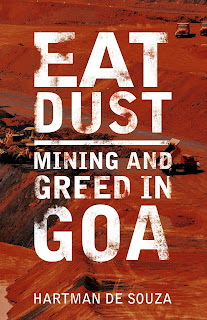Hartman de Souza has blessed
those interested in Goa and its history with his must-read book, Eat Dust: Mining and Greed in Goa. It is
no easy task to write about the mining industry. One can easily get bogged down
by facts and figures, and thereby disengage the reader without painting the
bigger picture of what mining means beyond extracting elements from the earth. With
great expertise, de Souza weaves his narrative from a compelling blend of
memoir, travelogue, and investigative reportage, taking the reader on a guided
tour around Goa’s mines. This approach to the writing lends the human touch to this
subject that it so desperately needs, drawing the reader in right from page
one.
The book focuses in
particular on the ongoing battle between the villagers of Cawrem and mining
giant Fomento, featured regularly in the Goa news and kept in our consciousness
via social media through the work of the locals and their supporters throughout
the state and the diaspora. Importantly, Eat
Dust also offers a reality check to those who still believe Special Status
is in the cards—or ever really was—for Goa.
de Souza’s ability to vividly
describe even the most grotesque and tragic images of Goa’s destruction will
keep the reader turning the pages with wonder at what he has to say next. Take,
for example, the following: “When they were done pumping the water out, there
was still a small amount left in the pit. That water would, like a festering
sore turn rancid and green with slime after a few days in the sun” (p. 18).
In de Souza’s impeccable
writing, one cannot help but be drawn in by his palpable love for Goa. The
frustration that can only come from such a deeply personal connection reaches a
climax in the following account of his choice to run away to Pune as operations
were about to accelerate in Maina and Cawrem:
I wanted to speak for the earth’s injured
voice, but needed to run away from my own notes and the pictures in my mind. By
early August 2008, they were beginning to eat circles in my head. I could even
see them in my sleep. Those days, I felt like swinging at anyone who even
suggested that the greed could be halted with our tactics and strategies. (p.
140)
Also commendable is the
author’s boldness in spotlighting individuals who have either contributed
directly to promoting the interests of the mining industry or who have shown
the kind of preference for greed over ethics that has helped fuel the rampant
apathy toward the obliteration of the environment. de Souza is not afraid to
name names!
There is no greater time than
the present to read this book. The title itself is indicative of the present
state of Goa. On a recent trip to the state, I was struck by the number of
people who now ride their scooter or motorcycle with their face covered, and
the chorus of coughs I heard during mass. I, too, found myself inhaling dust
while travelling short distances around North Goa. Perhaps we are all choking
on development!
My only criticism of Eat Dust is an editorial one. Much of the
material in the ‘Afterword’ is as essential to the text as the chapters that
precede it, particularly the takedown of trickle-down economics. Just as the
foreword is given the title ‘A Bird’s Eye View’, integrating it into the text
(because some readers will skip right to Chapter One), this should have been
accorded a descriptive title to clarify that its contents are integral to the
larger text.
Nevertheless, Eat Dust engages and leaves the reader
thinking about the future of Goa. What more can one ask of a book?














